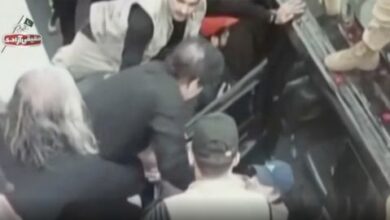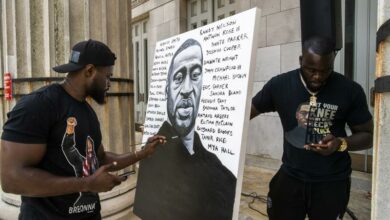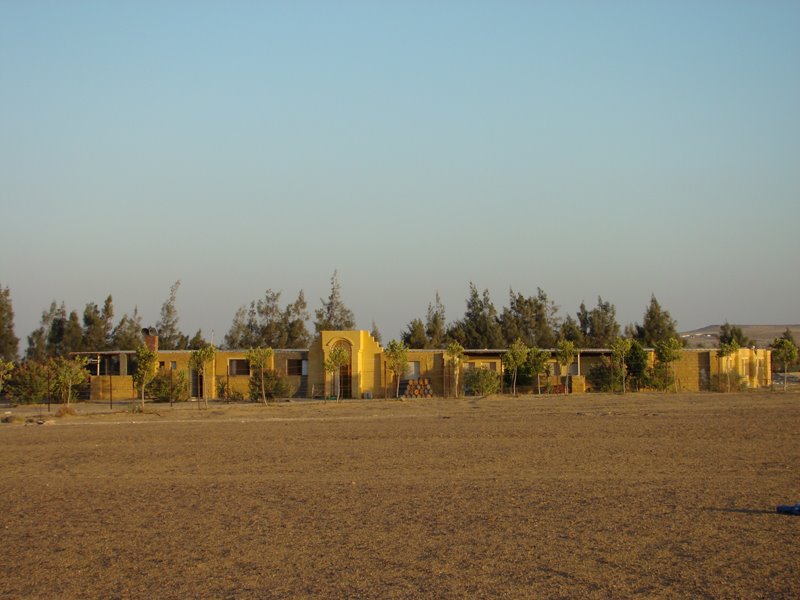On an unusually warm February morning, Al-Masry Al-Youm finds itself on a desert plain, sand stretching as far as the eye can see.
“Are you ready?” asks the approaching figure, a helmet on his head and another in his hands. This reporter briefly contemplates running away, but the thought is abruptly interrupted by a spare helmet being pushed down on his head. The inquiry regarding the state of readiness was–it turns out–only a formality.
Moments later, with a ferocious roar, a heavily-modified Toyota Land Cruiser tears through the desert, leaving a significant sandstorm in its wake as it skips across the uneven terrain. “Did you feel that?” the driver asks, his excitement audible through the static of the in-helmet intercom. “All four wheels were in the air!”
The driver is Tarek El Erian, who, at the age of 22, is the youngest cross-country rally racer in Egyptian history. He is also the youngest member of Sand Sea Sailors, an Egyptian rally team consisting of two other co-owners, three co-pilots, and a band of mechanics and racing enthusiasts all of whom share a common passion: competitive, off-road races over long stretches of car-crippling terrain. But to compare these cars to the kind congesting the streets of Cairo would be like comparing a steroid-addicted Olympian to someone barely qualified for a high school Frisbee team.
As if to prove the point, the Land Cruiser lets out a second mighty roar before freeing itself from the constraints of gravity. For one lingering moment, a whirlwind of sand erupts inside the car, prompted by the sudden jolt of tires against a low ridge. The touchdown is surprisingly smooth, courtesy of the car’s radically-enhanced suspension system.
“Suspension is everything,” explains El Erian, as the Land Cruiser assaults a range of sand dunes. “A driver needs to be able to feel every part of the car on the terrain. He should be able to control it. A strong engine is helpful, but cross-country rally races are all about getting over obstacles, which makes suspension more important. About a quarter of the total cost of this car went into its suspension system.”
With that, El Erian swerves suddenly, sending the car down the side of a steep embankment.
El Erian’s erratic driving is not an attempt to show-off, but rather a grueling test necessary for the recently installed engine. “My last engine burned out,” El Erian admits. “But that stuff happens. There are a lot of unpredictable risks involved in a sport like this.”
No sooner have the words left El Erian’s rattling jaw than this reporter spots a tiny nozzle jutting out of the sheet-iron dashboard, aimed squarely at the passenger seat, with an identical one for the driver. “Those are fire extinguishers,” explains El Erian.
El Erian, in response to Al-Masry Al-Youm’s increasingly worried tones, proceeds to point out all the mandatory safety precautions demanded by the FIA–the Fédération Internationale de l’Automobile–which is mandated with regulating this type of motor racing. “Just keep your eyes on the dashboard and tell me if you see any smoke coming out of it,” says El Erian. Whether or not he is serious remains unclear.
“This is actually a lot safer than normal on-road driving,” insists El Erian. Besides the automatic fire extinguishers, a thick iron ‘roll-cage’ running along the vehicle’s interior supports the veracity of his claim. The fuel tank is encased in the same semi-indestructible material used to build fighter jets, and the whole car is grounded thus preventing it from generating sparks that could result in fire.
Safety regulations also demand that all rally cars be equipped with external fire extinguishers and circuit breakers in case the driver (pilot) and his navigator (co-pilot) lose consciousness in a crash. Most noticeable of all safety precautions, though, is the crotch-mangling, five-point seatbelt system, which makes any movement in the specially designed sunken seats virtually impossible. Add to this a thick helmet squeezed over flame-retardant head-socks, as well as fireproof suit (fortunately deemed unnecessary for today’s test run), and you have all the ingredients for an excruciatingly uncomfortable ride.
“Imagine being strapped in tight for eight hours straight on a bumpy road with temperatures inside the car reaching 55 to 60 degrees,” says El Erian. “And we pay out of our own pockets to be able to do this.”
Unfortunately for El Erian and his teammates, though, pocket reserves are running at an all-time low.
Running on Empty
A few days earlier, Al-Masry Al-Youm met with a helmet-less El Erian in the tastefully decorated offices of an influential lawyer, where the young racer currently interns. Seated to his right was 32-year-old investment banker Hani Omar.
While the duo’s suits and the judicial setting might not immediately suggest it, both Omar and El Erian are two of Egypt’s most talented rally car racers. And while a good deal of young Egyptian men indulge in a bit of auto sport–mostly weaving irresponsibly amid oncoming traffic or collecting “Fast & the Furious” bumper stickers–these two take things a bit more seriously. For Omar and El Erian, rally car racing has been a lifelong passion.
“I remember watching the Pharaohs Rally on television when I was ten years old,” recalls Omar. “Back then, the rally had more exposure, and there was a daily half-hour television show that used to run throughout its duration. I’d watch it and dream of one day being able to participate.”
Omar’s dream came true in 2009, when he not only entered the rally that had captured his attention as a child, but performed outstandingly well for a beginner, finishing first at the end of the first day of racing. “I won that stage by 20 minutes,” he smiles, a hint of surprise still evident in his voice. “Usually, the difference is more like one or two minutes.”
Explaining his infatuation, El Erian recalls a similar story. “What attracted me was the Dakar Rally, which I’d watch as a child,” he says. “I started driving at a very early age; my mom would coach me. Since then, I’ve developed an even stronger love for driving. As soon as I turned 18, I got a 4×4, and started taking it out to the desert.”
Unsatisfied with aimlessly speeding around the desert, El Erian pursued his desire to race professionally and, despite his young age, managed to enter the 2006 and 2007 Pharaohs Rally as an accompanying vehicle before joining another racer’s assistance team for the 2008 race.
“I started racing properly in 2009, in a very underpowered truck,” he says. “It was very basic, I only put in the stuff that FIA wouldn’t let me race without. I was going to use a motorcycle helmet, but my mom ended up giving me money, which was nice of her,” he smiles. “Thank you, mom.”
Despite a less than stellar performance on the first day–due to the aforementioned burnt-out engine–El Erian ultimately impressed, coming in seventh overall: a remarkable feat for the youngest of 176 competitors. “After the first day, the other racers didn’t seem to think I was worthy enough for the competition,” El Erian says. “At the end of the race, though, I felt terrific. It was incredibly rewarding.”
The third member of the Sand Sea Sailors–and the one responsible for bringing Omar and El Erian together–is 34-year-old Abdel Hamid “Mido” Abou Youssef, who couldn’t make today’s meeting due to prior commitments. Being the oldest and most experienced member of the team, Mido currently holds the highest standing an Egyptian has ever received in rally car racing after a fourth-place finish in the 2007 Pharaohs Rally. Mido has also performed admirably in multiple other international races, including the Africa Race, in which he participated in 2009 and 2010 to reach third and fourth place, respectively.
Unfortunately, the trio’s talent–as well as that of their co-pilots, mechanics and assistants–has not been enough to earn the Sand Sea Sailors, or their beloved sport, the recognition they feel they deserve. Despite Cairo’s non-existent traffic laws and its abundance of sandy terrain, rally car racing is not even close to being the national sport. That honor clearly belongs to football, which, as far as most Egyptians are concerned, is really the only sport that exists.
“It’s ridiculous how much attention soccer gets compared to any other sport,” says El Erian. “Even the ones we’re good at. Abou-Treika’s knee surgery will beat Amr Shabana’s championship squash win to the headlines any day of the week.” El Erian claims that with so much attention focused on soccer, other sports end up suffering, especially ones that require significant amounts of cash. “This is an extremely expensive sport with low media coverage,” says Omar. “We’re constantly working just so we can finance it.”
“No exposure means no sponsorships,” explains El Erian. “But more sponsorships would make Egyptian rally teams better equipped for events, and achieve better results. Even with all our problems and the tight budgets that restricted what we could do, we still managed to achieve impressive results and that always felt great, beating teams that spend more in one day than we do in two years. The guy who won the last race I was in, his gearbox cost more than half the cost of my entire car.”
“This is our desert, our environment,” continues El Erian. “We live in it and have adapted to it ages ago. European racers come here and beat us not because they’re better at handling the desert, but because they have better funding.”
“As far as our team is concerned, we’re running out of money,” says El Erian. “I know I personally can’t spend any more. We’ve all given this a hundred percent of everything we have to give. The problem is none of us can stop racing.”
Also working against the team are the preconceived notions some potential sponsors might have of racing sports and racers, particularly young ones. “A lot of people think we just buy cars and crash them for kicks, but it’s not like that,” El Erian argues. “We’re very hands on, we’re entirely involved and committed in every way. We don’t sit there drinking Red Bull while our mechanics work. We’re there in the sand and up all night working just as hard as they are, taking the cars apart and putting them back together, planning, designing, tearing apart, rebuilding. We do it all.”
Omar agrees. “We risk our lives on a daily basis,” he says. “We go through hardships that no tennis player or football player ever endures. I think we have an interesting story, but the problem is very few people know about it.”
While their future remains unclear, the Sand Sea Sailors choose not to focus on the negative, instead immersing themselves in the demanding preparations for the upcoming El Gouna Rally, scheduled for 5-7 March. Besides requiring immense physical fitness, cross-country rally racing also takes a significant mental toll on drivers and their co-pilots.
“The physical preparation isn’t the worst part, although it’s definitely difficult,” says El Erian. “It’s the psychological strain that’s the real challenge. Especially towards the end of the race, where, if the rest of the team’s cars have suffered extensive damage, all the pressure is then transferred onto your shoulders.”
Omar nods solemnly. “A lot of people underestimate it, and then realize when it’s too late that they don’t have what it takes to spend twelve or twenty hours straight in a speeding rally car, with every wasted second counting against you.”
Somewhat childishly, Al-Masry Al-Youm asks about bathroom breaks. The answer comes in the form of an intense stare and a half-smile from Hani Omar. “Some drivers will waste time on that, others will wait till they have to get out of the car to fix something. But the real professionals wear Pampers.”
The Sand Sea Sailors will be participating in the upcoming El Gouna Rally on 5-7 March. For more information on the team and any upcoming events, please visit their website.




